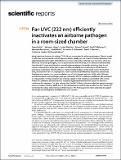Files in this item
Far-UVC (222 nm) efficiently inactivated an airborne pathogen in a room-sized chamber
Item metadata
| dc.contributor.author | Eadie, Ewan | |
| dc.contributor.author | Hiwar, Waseem | |
| dc.contributor.author | Fletcher, Louise | |
| dc.contributor.author | Tidswell, Emma | |
| dc.contributor.author | O'Mahoney, Paul | |
| dc.contributor.author | Buonanno, Manuela | |
| dc.contributor.author | Welch, David | |
| dc.contributor.author | Adamson, Catherine S | |
| dc.contributor.author | Brenner, David J | |
| dc.contributor.author | Noakes, Catherine | |
| dc.contributor.author | Wood, Kenny | |
| dc.date.accessioned | 2022-03-24T09:41:21Z | |
| dc.date.available | 2022-03-24T09:41:21Z | |
| dc.date.issued | 2022-03-23 | |
| dc.identifier | 278396841 | |
| dc.identifier | 3ed71fae-fe8d-4a9a-95a8-334ef8548c90 | |
| dc.identifier | 85126834632 | |
| dc.identifier | 000772605500082 | |
| dc.identifier.citation | Eadie , E , Hiwar , W , Fletcher , L , Tidswell , E , O'Mahoney , P , Buonanno , M , Welch , D , Adamson , C S , Brenner , D J , Noakes , C & Wood , K 2022 , ' Far-UVC (222 nm) efficiently inactivated an airborne pathogen in a room-sized chamber ' , Scientific Reports , vol. 12 , 4373 . https://doi.org/10.1038/s41598-022-08462-z | en |
| dc.identifier.issn | 2045-2322 | |
| dc.identifier.other | ORCID: /0000-0001-7673-5212/work/110423110 | |
| dc.identifier.uri | https://hdl.handle.net/10023/25088 | |
| dc.description | Funding: We acknowledge the financial assistance of the United Kingdom’s Department for Health and Social Care (2020/092). | en |
| dc.description.abstract | Many infectious diseases, including COVID-19, are transmitted by airborne pathogens. There is a need for effective environmental control measures which, ideally, are not reliant on human behaviour. One potential solution is Krypton Chloride (KrCl) excimer lamps (often referred to as Far-UVC), which can efficiently inactivate pathogens, such as coronaviruses and influenza, in air. Research demonstrates that when KrCl lamps are filtered to remove longer-wavelength ultraviolet emissions they do not induce acute reactions in the skin or eyes, nor delayed effects such as skin cancer. While there is laboratory evidence for Far-UVC efficacy, there is limited evidence in full-sized rooms. For the first time, we show that Far-UVC deployed in a room-sized chamber effectively inactivates aerosolised Staphylococcus aureus. At a room ventilation rate of 3 air-changes-per-hour (ACH), with 5 filtered-sources the steady-state pathogen load was reduced by 98.4% providing an additional 184 equivalent air changes (eACH). This reduction was achieved using Far-UVC irradiances consistent with current American Conference of Governmental Industrial Hygienists threshold limit values for skin for a continuous 8-h exposure. Our data indicate that Far-UVC is likely to be more effective against common airborne viruses, including SARS-CoV-2, than bacteria and should thus be an effective and “hands-off” technology to reduce airborne disease transmission. The findings provide room-scale data to support the design and development of effective Far-UVC systems. | |
| dc.format.extent | 1595141 | |
| dc.language.iso | eng | |
| dc.relation.ispartof | Scientific Reports | en |
| dc.subject | Far-UVC pathogen airborne | en |
| dc.subject | COVID-19 | en |
| dc.subject | RA0421 Public health. Hygiene. Preventive Medicine | en |
| dc.subject | NDAS | en |
| dc.subject | SDG 3 - Good Health and Well-being | en |
| dc.subject.lcc | RA0421 | en |
| dc.title | Far-UVC (222 nm) efficiently inactivated an airborne pathogen in a room-sized chamber | en |
| dc.type | Journal article | en |
| dc.contributor.sponsor | Scottish Funding Council | en |
| dc.contributor.institution | University of St Andrews. School of Biology | en |
| dc.contributor.institution | University of St Andrews. Biomedical Sciences Research Complex | en |
| dc.contributor.institution | University of St Andrews. Centre for Biophotonics | en |
| dc.contributor.institution | University of St Andrews. School of Physics and Astronomy | en |
| dc.identifier.doi | https://doi.org/10.1038/s41598-022-08462-z | |
| dc.description.status | Peer reviewed | en |
| dc.identifier.grantnumber | N/A | en |
This item appears in the following Collection(s)
Items in the St Andrews Research Repository are protected by copyright, with all rights reserved, unless otherwise indicated.

